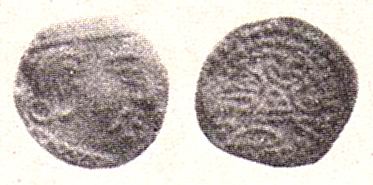 | ||
The Traikutakas were a dynasty of Indian kings who ruled between 388 and 456. The name "Traikutakas" seems to be derived from the words for a three-peaked mountain ("Tri-kuta"). The Traikutakas are mentioned in Kalidasa's Raghuvamsa, in which they are located in the area of northern Konkan. The dominions of the Traikutakas further included Aparanta and northern Maharashtra.
Contents
The coins of the Traikutaras are found extensively in southern Gujarat, and southern Maharashtra beyond the Ghats. Their design is very close to that of the Western Satraps, from which they probably inherited some territories, and traces of the obverse legend with Greek letters can still be seen.
Traikuta rule of Aparanta or Konkan begins in A.D. 248 (Traikuta era) exactly the time of Abhira Ishwarsena rule, hence Traikutas are identified with the dynasty of Abhiras.
The Traikutakas reckoned in a specific era, known as the Traikutaka era, or usually the Kalachuri or Chedi era, starting in 249.
Trikuta-Abhiras
It is generally supposed that Traikutakas were a different dynasty of Abhira, and hence are sometimes called Abhira-Traikutakas . Indradutta, Dahrasena & Vyaghrasena were well known kings from this dynasty. Traikutikas were known for their Vaishnava faith, who claimed to be Yadav of Haiheya branch and Dahrasena performed Ashvamedha yajna too
Traikutaka rulers
The following Traikuta rulers are known from the coins and inscriptions of Gupta period-
